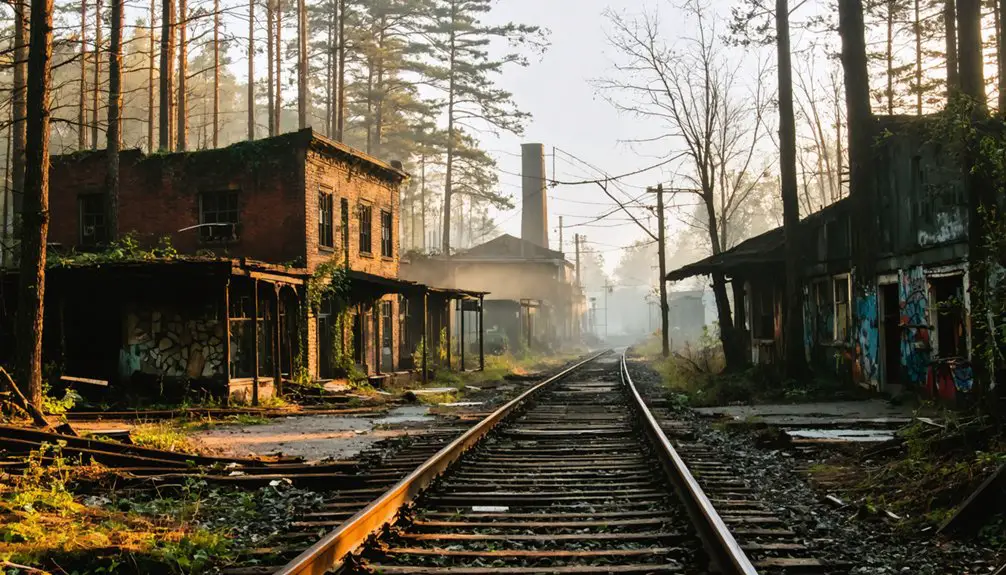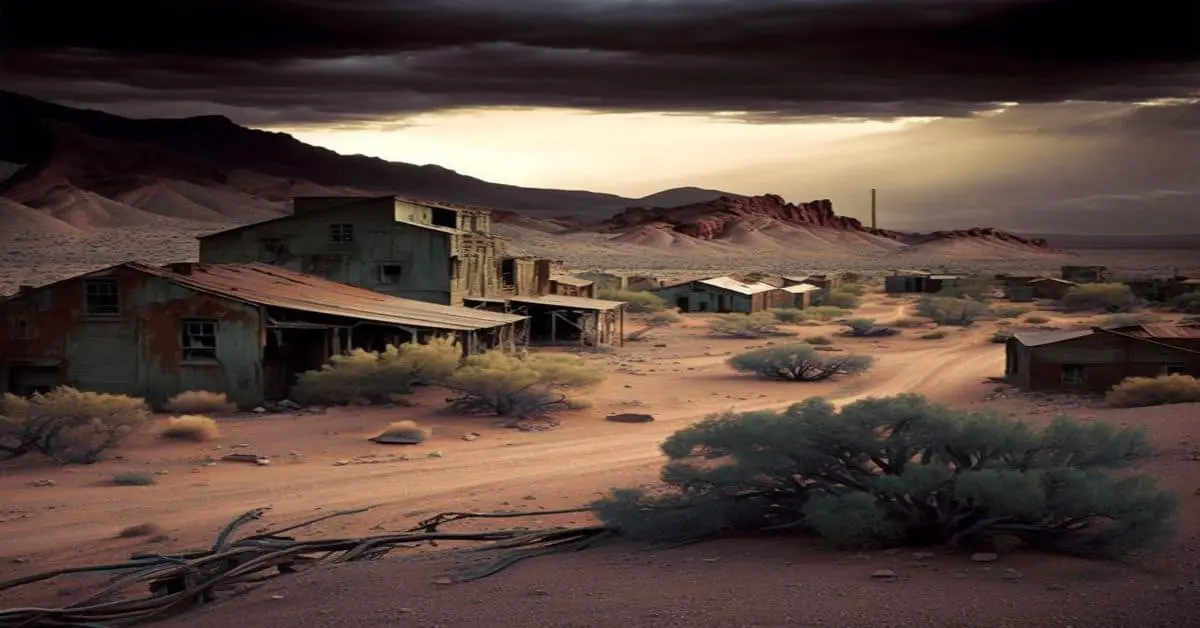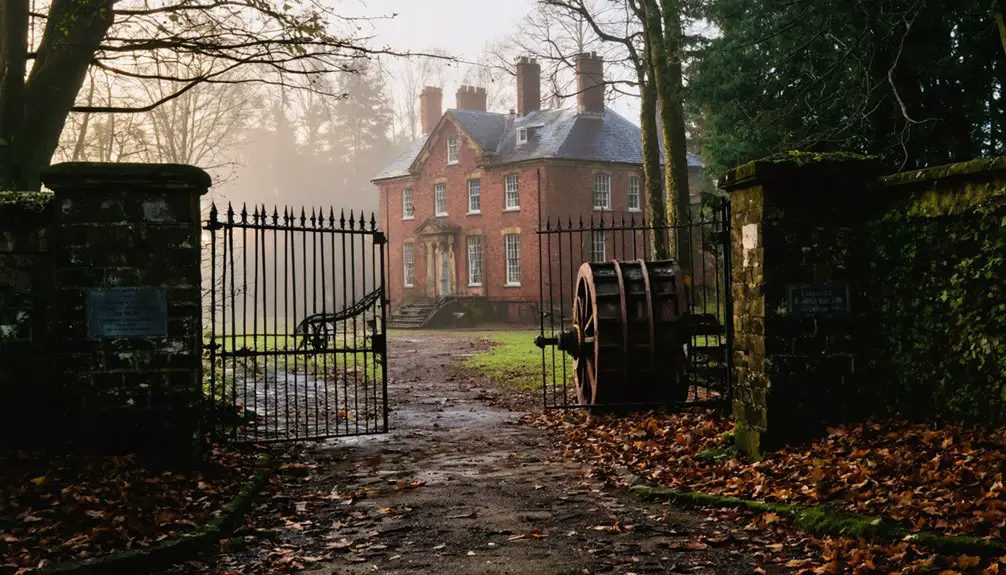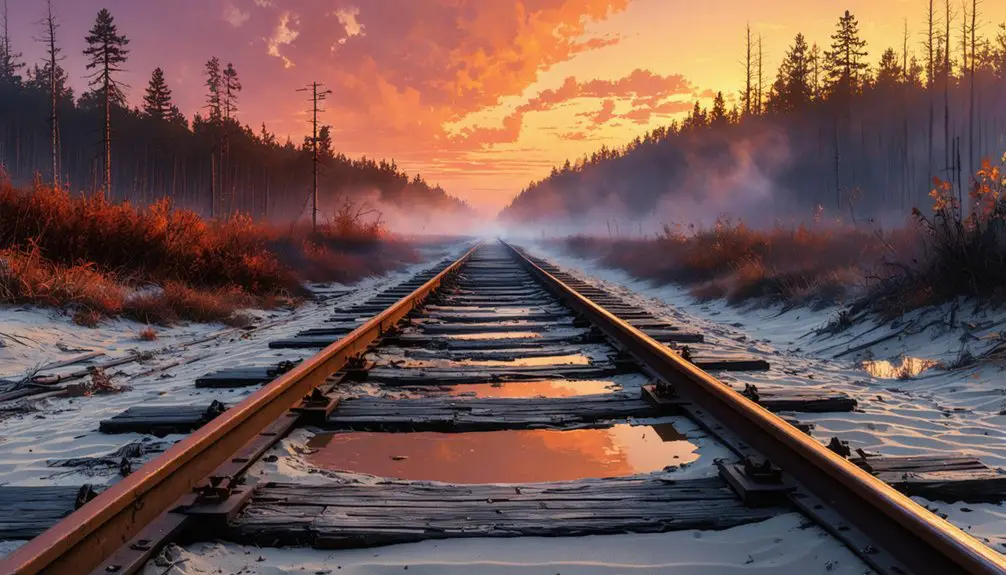You’ll find Crossley nestled in New Jersey’s Pine Barrens, where clay mining operations thrived in the late 1800s under the George C. Crossley Company. This industrial hub featured worker cottages, local shops, and a donkey railroad system until economic decline led to its abandonment. Today, the ghost town‘s former mining pits have transformed into vibrant wetlands within Berkeley Township’s preserved parkland, where nature’s reclamation reveals fascinating layers of history.
Key Takeaways
- Crossley was a thriving clay mining town in New Jersey’s Pine Barrens that became abandoned after clay deposits depleted and rail connections ceased.
- The George C. Crossley Company operated the town’s clay works until the 1920s, when the Cypress Land Company acquired the property.
- Former mining pits have transformed into natural ponds, creating habitats for Pine Barrens tree frogs and diverse wetland species.
- The ghost town site is now part of Berkeley Township’s preserved parkland, featuring self-guided trails through abandoned structures.
- Visitors can explore historic industrial ruins while observing wildlife and seasonal landscape changes in the reclaimed natural area.
The Rise of a Clay Mining Town
When clay deposits were discovered in New Jersey’s Pine Barrens during the late 1800s, the town of Crossley emerged as a significant hub for clay mining operations.
You’ll find that Crossley Clay Works initially established the town’s industrial foundation, implementing clay extraction techniques that yielded high-grade materials for bricks, terracotta pottery, and pipes.
The Cypress Land Company acquired the property in the 1920s, marking a transition in the town’s history.
The industrial community dynamics centered around a “donkey” railroad system that connected mining pits to main transportation routes, enabling wider distribution of Crossley’s products.
Donkey railways formed the backbone of Crossley’s clay operations, linking extraction sites to major shipping routes for nationwide distribution.
When the George C. Crossley Company took ownership in 1914, they continued to capitalize on the region’s rich clay beds, which were particularly valued for fire-clay and stoneware production.
The town’s strategic location within the broader clay district and its railway access helped cement its position as a essential contributor to New Jersey’s thriving clay industry.
Today, visitors can explore the old mining pits that have naturally transformed into scenic ponds along the Thomas F. Hampton Trail.
Daily Life in Industrial Crossley
If you’d lived in early 1900s Crossley, you’d have resided in one of the modest worker cottages clustered near the clay mining operations and factories.
Your daily routine would have centered around the local shops that served the working-class community, offering essential goods within walking distance of both homes and workplaces.
After long shifts at the factories, you might’ve found recreation at community gathering spots where workers’ families socialized and strengthened their industrial town bonds.
With a local low tax rate of $2.15, residents could afford to maintain their homes and support their families on factory wages.
Many residents worked at Crossley machinery works, which manufactured specialized equipment for clay processing from its founding in 1879 until closing in 1999.
Mining Workers’ Living Conditions
Despite the harsh industrial realities of late 19th-century mining towns, daily life in Crossley centered around a close-knit community of workers who shared both the burdens and bonds of their challenging existence.
Similar to the industrial developments seen during the pre-Revolutionary times, mining communities formed tight social bonds through shared labor experiences.
Today, remnants of this industrial past can still be seen along the former rail bed that once served the Pennsylvania Railroad through the area.
You’d find worker accommodations consisted of basic company-provided housing located near the mining operations, enabling quick access to work sites while fostering community connections.
The demanding nature of clay mining life was evident in three key aspects:
- Health hazards were constant companions, from dust exposure to the physical toll of manual labor.
- Living quarters were utilitarian and temporary, reflecting the transient nature of industrial settlements.
- Daily routines revolved around exhausting pit work, with minimal leisure facilities available.
These conditions shaped a resilient community where workers relied on each other for support and solidarity through their shared experiences.
Local Shopping and Recreation
The daily rhythms of Crossley extended beyond the mines into a modest but functional network of local businesses and social spaces.
You’d find shopping trends centered around general stores and specialty shops that catered to the industrial workforce’s basic needs, while the Crossley Manufacturing Company’s 84 employees helped sustain local commerce. The company was known for refusing to sell equipment to breweries, maintaining strict religious principles in their business dealings.
For recreational activities, you could join social gatherings at company facilities or community halls, though options were relatively limited. The opening of Glenk’s restaurant in the converted mansion around 1923 gave you a more formal dining venue.
When you needed broader shopping or entertainment choices, nearby Trenton’s established commercial district offered everything from brick manufacturers to lamp shops, making it a convenient destination for Crossley residents seeking additional amenities beyond their immediate community.
Mining Operations and Economic Growth
During the late 1800s, Crossley emerged as a significant clay mining hub, where extensive operations yielded raw materials for pottery, brick, terracotta, and pipe production.
The industrial legacy of this era shaped the region’s economic diversification through the George C. Crossley Company’s acquisition of the Crossley Clay Works in 1914. The area gained further prominence as the birthplace of Archibald Maddock Crossley, who would later revolutionize public opinion research.
You’ll find evidence of this thriving past in three key developments:
- The “donkey” railroad system that transported clay from mining pits to broader markets
- The creation of local employment opportunities in mining and manufacturing
- The integration with Pennsylvania Railroad infrastructure, enabling regional distribution
The mining operations eventually ceased in the early 1900s, but their impact on local development remained significant, as former clay pits transformed into wildlife-supporting ponds that you can still observe today. These historic sites now form part of the Thomas F. Hampton Trail, offering visitors a unique glimpse into the area’s industrial heritage.
The Path to Abandonment
Crossley’s decline began with a gradual but relentless chain of events in the early 1900s, driven by multiple economic and industrial factors.
You’ll find that the depletion of viable clay deposits coincided with diminishing market demand, triggering an economic downturn that rippled through the community.
The situation worsened when Penn Central abandoned its rail line, severing essential transportation links for goods and workers.
The loss of Penn Central’s railway dealt a devastating blow, cutting off vital lifelines that had sustained Crossley’s economic heartbeat.
As urban decay set in, you’d have witnessed the exodus of working families seeking opportunities elsewhere.
The change of land ownership from Crossley Clay Works to Cypress Land Company marked the final chapter of industrial activity.
A series of devastating factory fires in 1866 severely impacted local manufacturing capabilities and employment.
Without maintenance, community structures deteriorated, and local businesses shuttered.
Natural Transformation and Wildlife Haven
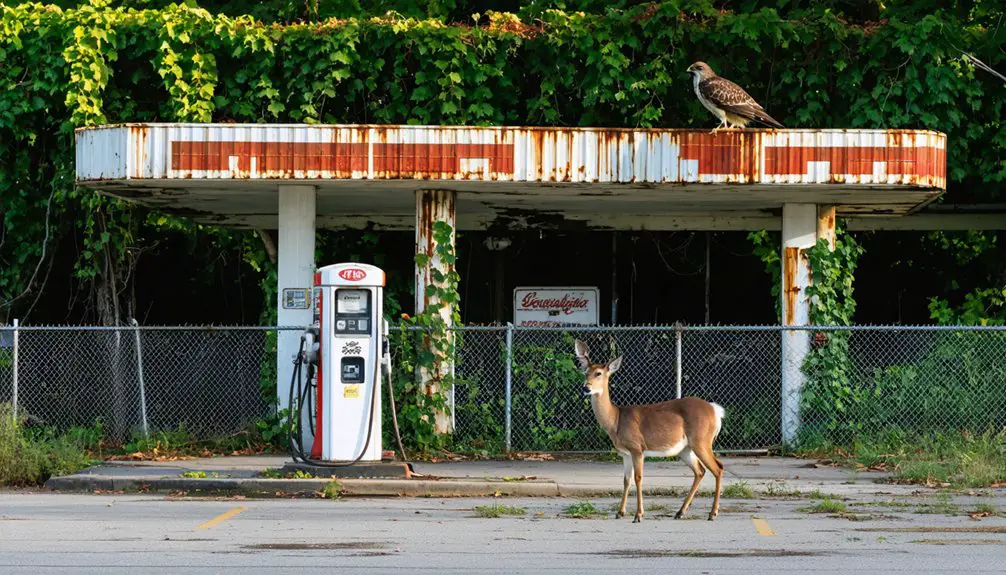
You’ll discover the former clay mining pits have transformed into vibrant ponds that now serve as critical breeding grounds for the rare Pine Barrens tree frog.
Nature’s reclamation of Crossley’s industrial scars has created diverse wetland habitats, supporting native amphibians and aquatic plants like Knieskern’s beaked rush.
The preserve’s mix of upland and lowland pine forests, alongside these naturally formed ponds, demonstrates how abandoned industrial sites can evolve into thriving wildlife sanctuaries.
Ponds Support Rare Frogs
The abandoned ponds and wetlands of Crossley have evolved into essential sanctuaries for several rare amphibian species, including the threatened Pine Barrens Treefrog and Atlantic Coast Leopard Frog.
These specialized frog habitats feature acidic waters in Atlantic white-cedar swamps and dense vegetation that’s critical for their survival.
You’ll find these remarkable amphibian conservation efforts center around three key habitat features:
- Sphagnum moss carpets and hardwood stands that create significant microhabitats for shelter
- Connected upland and wetland areas that enable seasonal breeding migrations
- Surrounding forests and soils that maintain proper moisture levels and environmental conditions
Despite threats from habitat fragmentation and road mortality, these transformed ponds continue supporting rare species while contributing to the region’s ecological health through pest control and nutrient cycling.
Mining Scars Turn Green
Over decades of natural reclamation, barren mining scars across Crossley have transformed into vibrant ecological havens through progressive stages of revegetation and habitat development.
You’ll find native grasses, shrubs, and hardwoods now colonizing former tailings, while old mining depressions have become life-sustaining wetlands.
This vegetative succession has dramatically improved local conditions. As plants take root, they stabilize soil, reduce erosion, and create diverse wildlife habitats.
You’ll spot birds nesting in emerging forests, frogs breeding in newly formed ponds, and small mammals finding shelter in the undergrowth.
The ecological restoration extends beyond aesthetics – these recovering landscapes now filter water, sequester carbon, and provide essential corridors connecting fragmented habitats.
What was once a wasteland has become a reflection of nature’s resilience.
Exploring the Ghost Town Today
Located within Berkeley Township’s preserved parkland, Crossley offers visitors an intriguing blend of historical remnants and natural wilderness.
You’ll encounter a ghost town exploration experience managed by the New Jersey Natural Lands Trust, where nature immersion meets cultural heritage among diverse habitats of wetlands, forests, and meadows.
When visiting Crossley today, you’ll find:
- Self-guided trails winding through abandoned structures and ruins, now embraced by native vegetation.
- Rich wildlife viewing opportunities, including deer and various bird species typical of Pine Barrens ecosystems.
- Seasonal landscape transformations that create unique photography and observation experiences throughout the year.
While no formal tours exist, informational signage and maps help you navigate the preserve’s network of paths, allowing for independent discovery of this fascinating intersection of history and nature.
Cultural Legacy and Historical Significance
Beyond its physical remnants, Crossley stands as a compelling tribute to New Jersey’s industrial heritage, particularly through its pioneering role in clay mining during the late 1800s.
Crossley’s legacy echoes through time as a monument to New Jersey’s clay mining pioneers who shaped the state’s industrial foundation.
You’ll find the town’s legacy preserved through cultural preservation efforts that connect modern visitors to Ocean County’s rich industrial past. The site’s transformation from a bustling clay-mining center to a protected natural preserve reflects the region’s evolving relationship with its resources.
Through historical education programs at the Crossley Preserve, you can explore how the George C. Crossley Company shaped local development and learn about the town’s connection to the Brooksbrae Terracotta Brick Factory.
The preserve’s interpretive trails now weave together stories of industrial ambition and environmental stewardship, ensuring Crossley’s significance endures for future generations.
Frequently Asked Questions
Are There Any Supernatural Legends or Ghost Stories Associated With Crossley?
Despite 2,948 acres of seemingly haunted landscapes, you won’t find documented spectral sightings at this location. Historical records focus on clay mining operations rather than supernatural tales from the abandoned town.
What Happened to the Machinery and Equipment After the Town’s Abandonment?
You’ll find most machinery was sold or removed during ownership changes, with equipment disposal occurring as operations ceased. No significant machinery preservation efforts left industrial equipment at the site.
Did Any Original Crossley Buildings Survive to the Present Day?
Like resilient Victorian ghosts, you’ll find the White Hill Mansion still stands today, complete with its historical significance intact through preserved architectural features like oriel windows and early 1900s additions.
Were There Any Notable Accidents or Disasters During Crossley’s Mining Operations?
You won’t find documented mining accidents or disaster reports specific to Crossley’s operations, though the area’s abandoned mines, like others in northern New Jersey, continue affecting infrastructure through sinkholes.
What Specific Types of Clay Products Were Manufactured in Crossley?
You’d find diverse porcelain products manufactured there, including high-voltage insulators, ceramic tiles, electrical wiring components, pottery items, and lighting fixtures – all shaped through dry pressing and casting methods.
References
- https://proficientplumbingheating.com/crossley-preserve/
- https://www.youtube.com/watch?v=ZIp3AYb0ulw
- https://dep.nj.gov/njnlt/crossley-preserve/
- https://kids.kiddle.co/Crossley
- http://forums.njpinebarrens.com/threads/ghost-of-the-pines-documentary.7656/
- https://www.traillink.com/trail/thomas-f-hampton-trail-(crossley-preserve-trail)/
- http://oceancountynjhistory.blogspot.com/2021/12/crossley-clay-mine-to-become-iron-works.html
- http://www.nbfplarchive.org/nbrevitalization/files/nb_images/belvin_photos/cayton/cayton_history_of_union_middlesex_counties_1882_middlesex_county_soil.htm
- https://mycompanies.fandom.com/wiki/Crossley_Machine_Company
- https://www.trentonhistory.org/Made/Industries1901.html
